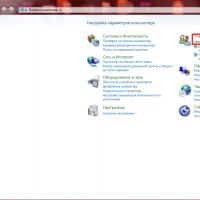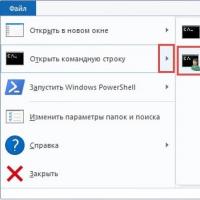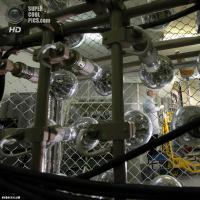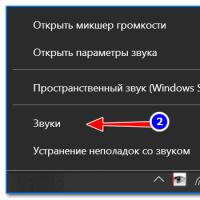How to determine the presence of hdmi on the motherboard. How to enable HDMI on a laptop. Real offers from manufacturers
I decided to prepare a separate article in which to tell in detail and show by example how to connect a TV to an ordinary stationary computer with via HDMI cable. The topic is relevant, and I am often asked about it. In fact, nothing is complicated. But there are some nuances that we will try to understand within the framework of this article.
Almost every, not even the newest, TV has at least one HDMI input. And in the computer, on the back of the system unit, there is an HDMI output. This means that we can easily connect a PC to a TV using a regular HDMI cable, which can be bought in every digital equipment store.
Why connect them? Everything is very simple. The TV can work as a monitor. That is, you can display the image from the computer on the TV screen. The TV can be used as a main monitor or as a second monitor. This means that the image from the PC will be displayed on the screen of a conventional monitor and TV at the same time. Or just on TV. It already depends on your tasks. It should be noted that not only image, but also sound is output via HDMI.
I myself, and other users, most often connect a PC to a TV to watch movies on big screen, or for the game. You can also connect a gamepad to your computer and play on the big screen. Some people use televisions instead of monitors. They work with documents, surf the Internet, etc. But it seems to me that this is not very convenient. And the eyes get tired faster. For permanent work it is better to use a monitor at the computer. And connect the TV to watch movies, photos, games, etc.
The connection process will be the same for TVs from different manufacturers: LG, Samsung, Sony, Philips, Panasonic, Ergo, Hitachi, etc. In the same way, there will be no major differences in Windows settings... Yes, the settings in Windows 10, Windows 8, Windows 7 are slightly different, but not critical. I'll show you everything.
If you have a laptop, you can do everything according to this article:.
Preparation: check the HDMI ports on the TV and computer, choose the cable
First, we need to check if our devices have the required ports. We also need an HDMI cable to connect. Let's take a closer look at everything. If you have everything, then you can go directly to the connection and configuration.
If you have ports on both devices and have a cable, then you can connect.
We connect the TV to the computer using an HDMI cable
You just need to take a cable, connect it to the HDMI output on the computer and to the HDMI input on the TV.
Important! Devices must be connected when they are off and power off. There is a risk of burning ports. There are such cases.
If you connect the TV as a monitor, that is, a single screen, then the diagram will look something like this:

Let's also consider another case when a TV and a monitor will be connected at the same time.
TV as a second monitor for PC
The monitor can also be connected via HDMI (as in my photo below), over DVI, or even over VGA. As a result, two screens will be connected to the PC.

We figured out the connection. Most likely, in your case there will already be system unit with a monitor connected to it. And all that needs to be done is to connect another TV to it.
Select HDMI input as a signal source in TV settings
Most often, after connecting and turning on the devices, there is no image on the TV. An inscription like "No signal", "No signal source selected" or something like that will appear. On the TV, you need to select the signal source. The port where we connected the cable.
For this, your TV remote control must have a separate "SOURCES" or "INPUT" button.

After clicking on it, a menu should open in which you can select a signal source. You can see which port on the TV you connected the cable to (each port has its own number)... Or just select an active source. The actual process may differ depending on the TV. I have an old LG.

An image from the computer should appear on the TV. This will be either a copy of what is displayed on the monitor (if any), or a clean desktop (expand).
The main thing is that the picture from the computer appeared on the TV screen. Further, in the Windows settings, we can already change the image display mode. There are several of them.
Setting up an HDMI-connected TV in Windows
The screen resolution is adjusted automatically in most cases. So in the Windows settings, we can only change the mode of operation with multiple displays. This is only relevant when a monitor and TV are connected to the PC. If there is only one display, then these settings are not needed.
The easiest way to change the mode in Windows 10, Windows 8, and Windows 7 is with a keyboard shortcut Win + P.

After clicking on them, the "Project" menu will appear. In the top ten, it looks like this:

In Windows 7 like this:

Let's take a closer look at each mode.

In most cases, these settings are sufficient.
Additional screen options
To open them, just right-click on an empty area of the desktop. In Windows 10 you need to select "Display Settings", and in Windows 7 - "Screen Resolution".

A window with settings will open, where you can see how many screens are connected to the computer.

You can also define them (by clicking on the "Define" button), change the resolution of each screen and the mode of operation (which I talked about above).

In Windows 7, the settings for a TV connected via HDMI look like this:

With the adjustment of the image on the computer sorted out.
What if the sound from the computer is not going to the TV?
This happens very often. The image appears on the TV, but there is no sound. It's not there at all, or it sounds from a computer connected speaker system... If you want the sound to go through the TV, then the first step is to check if the sound on the TV is muted or twisted.

Your TV should be in the list of devices. You need to right-click on it and set "Use as default".

If the TV is not in the list, then right-click on an empty area and check the boxes next to two items: "Show disconnected devices" and "Show disconnected devices".

If this does not help, and there is still no sound from the PC on the TV, then try reinstalling the video card driver. Just download it and run the installation. Let the HDMI cable be connected to the computer at this moment.
How to check these settings in Windows 7, I showed in the article. Be sure to check it out and read the comments. There is a lot of useful information there.
I have never encountered the problem of audio output via HDMI. How many I connected, everything worked immediately after connecting. But there is such a problem.
Connecting 4k TV to computer. Ultra HD over HDMI
If you have an Ultra HD TV (aka 4k) and the video card supports this resolution, then there is a chance to get a beautiful and sharp image... I checked, everything works. I have a 4k TV from Philips. And in the computer the videocard GeForce GTX 750Ti which supports resolutions up to 4096x2160.
There are a lot of nuances. I'm not a gamer, so I'll try to explain as best I can. The fact is that you can display a 4k image via HDMI, and I did it. But most likely we will get a refresh rate of 30 Hz. Which is very little. To get 60Hz, we need a video card with HDMI 2.0 and the same cable. That is why they use DVI cables to connect to 4k monitors. And I have not seen something in DVI TVs.
I connected everything, started the computer, and saw that the image on the TV was somehow strange, the wrong colors. Perhaps this is only in my case.

Everything can be solved very simply. First, I tried to disable UHD (Ultra HD) for the HDMI port to which the PC is connected in the TV settings. The image is normal, but the resolution is normal, 1920x1080. Therefore, this method is not very suitable for us.
To get a real 4k image with natural colors, you just need to change the screen resolution to the maximum 3840x2160 in the display properties in Windows 10.

The image returned to normal immediately. The scale was also automatically set to 300%. Otherwise, everything would be very small. It can be changed if necessary. I have not tried to play at this resolution. But I think that this is not real. Moreover, the video card on my computer is not the newest and most powerful.
I look forward to your comments. Ask questions and don't forget to share tips. Best wishes!
An actual problem for many users today is image expansion with personal computer home plasma display. “We connect the TV to the computer via HDMI, but there is no picture,” - this is how the negative sounds from the lips of the owners of computer equipment.
In this article, the reader will get acquainted not only with the method of connecting an additional display to a PC or laptop, but also learn about correct settings equipment. He will also be interested in the recommendations of experts in the field of IT technologies.
About the pursued goals
The larger the diagonal of the LCD screen, the more comfortable it is to view multimedia and the better the image detail in games and software. A film on TV from a computer will allow you to see the smallest details, and a fan of a dynamic toy will feel the reality of the events taking place on a plasma screen. In fact, there are many advantages of using such a symbiosis, and they all relate to the user's comfortable work or leisure.
In recent years, many users have become interested in Internet TV. Why pay money to a provider when you can watch your favorite channels from the official website of a television company for free? Therefore, the question: "How to bring the computer to the TV?" sounds more and more often in the media mass media... But with ready-made solutions, things are still bad.
Computer hardware capabilities
Better to start with the technical capabilities of a personal computer or laptop. The point is that it is not enough to buy an HDMI cable for your computer. It will be possible to connect to the TV only if there is an appropriate digital output video on PC. Therefore, the user needs to familiarize himself with all outputs of the system unit and find desired port... It can be located on a video card or on motherboard at the computer and at one of the ends of the mobile laptop.

There are devices that do not have an HDMI connector. It is quite possible to find on older video output VGA (D-Sub) or digital ports DVI with DisplayPort. It all depends to a greater extent on the TV, which should have similar inputs. Having chosen the right cable for the TV, you will always find the opportunity to display the image from the computer.
TV availability
But modern LCD devices with HDMI ports have no problems - all manufacturers provide their equipment with a popular interface. Often they are not limited to one port at the factory and provide the user with the ability to connect multiple sources to output images via HDMI.
Large LCD displays have a slightly different problem. We are talking about the resolution of the reproduced picture and the frame rate. Before connecting the computer and TV via HDMI, the user needs to familiarize himself with technical characteristics both devices, compare their video transmission capabilities and find a parameter that will be supported by both plasma and PC. Often, all equipment manufacturers strive to ensure that their equipment supports FullHD resolution (1920 × 1080) at 60 Hz. True, there are exceptions that create problems for users.
Operation of devices of different generations
In situations involving the connection of two devices with different interfaces (HDMI, VGA), users often wonder why the computer does not see the TV via HDMI. Everything is explained simply - it is impossible to combine technology different generations by combining analog and digital signal with one cable. In such situations, no adapter will solve the problem - you need a converter that can decode the signal at the hardware level.

Fortunately, foreign auctions are present ready-made solutions, which are able to solve all the problems of users with the transmission of video signals between devices of different generations. The cost of one converter is in the range of 20-30 USD. That is, what attracts a potential buyer. All the necessary cables for video transmission are always included with the converter, so the algorithm for solving the problem is simple: buy a converter and connect the TV to a computer via HDMI.
When you don't have the right interface
Not all computers and TVs have an HDMI port - that's a fact. But you shouldn't get upset ahead of time, since the problem can always be solved with obsolete devices. The fact is that old equipment is focused on transmission analog signal... Let the quality of the image this technology and lags behind, however, it has an order of magnitude fewer problems with the compatibility of different standards. Combining S-Vidio, VGA or RCA interfaces is much easier than converting to digital.
The user just needs to buy a cable for the TV and connect both devices. There are also many inconveniences that users will have to face. First, audio cannot be transmitted over the interface cable. Accordingly, you need to buy another cable. Secondly, during operation, the sound card of a computer or laptop will not be able to create an individual audio stream for the TV. Accordingly, you can forget about the convenience of sharing a computer and TV.
The right approach to buying a cable
Users may also experience problems when choosing the wrong HDMI cable. The fact is that digital video signal is not capable of being transmitted over long distances over a cable without loss of quality. Therefore, the future owner needs to decide on the length before buying an HDMI cable for a computer to a TV.

The main thing is to always remember that the longer a quality cable is, the higher its cost. It is necessary to measure the distance between the PC and the liquid crystal display (of course, not in line of sight, but taking into account the installation) and find a cable of the appropriate length on the market. Yes, it is customary for buyers to purchase wires with a margin, but it should be small, since often the surplus is rarely in demand - more often they just collect dust at the TV or at the computer. The main thing here is to find a middle ground in terms of the cost-to-cable length ratio.
Real offers from manufacturers
HDMI to HDMI TV cable is not easy to choose in the market. Any buyer can be convinced of this on his own, just look at the prices and assortment. It is logical to assume that expensive accessories have a high price just because they are made by serious brands. There is truth in this, but, as practice shows, the more expensive HDMI cable, the less likely it is that the video signal will deteriorate over a long distance. In fact, you have to pay for the quality. Chinese consumer goods have no place in the domestic market.
IT experts recommend paying attention to the brand name (for example, Prolink, Cablexpert, Viewcon, Belkin), as well as focusing on the quality of the winding and the presence of ferrite filters near the connectors (barrels near the contacts). If an HDMI cable is required, the length of which exceeds 30 meters, then the user cannot do without a signal amplifier. The device is expensive, but it copes with the tasks 100%.
Physically connecting two devices
This article is not about the potential difference from the school physics course, but the user still needs to know that there is a small electric charge... Naturally, when two devices are connected, a technician with a large charge will transfer energy through a cable to the port of the connected device. Often, the TV turns out to be more powerful, which, when connected, burns the output on the computer's video card. Therefore, before connecting the computer to the TV via HDMI, you need to disconnect the power from one of the devices (remove the plug from the outlet). Naturally, this problem bypasses all users who have grounding in the house.
Another trouble that a buyer may encounter is the lack of a video signal when connecting the cable or image transmission with interference. You do not need to touch the settings of your TV or computer - 99% of the problem is in a poor-quality cable. We need to replace it. In general, experts recommend checking the HDMI cable directly in the store to avoid connection problems.
TV settings
It will not be difficult for the owner of the LCD display to remote control device press the "Source" button and select the desired signal source. All ports on the TV panel are registered and numbered, so all that remains is to combine the software with the hardware. You don't have to expect the PC image to appear on the screen right away. The main thing here is to make the display ready to receive a video signal. This completes the setup for connecting the TV to a computer via HDMI. It remains only to configure the video output of a PC or laptop.

Many users own home theaters and other video and audio equipment that are connected to an LCD TV. Naturally, a situation may arise when all HDMI ports are busy. Many users are unlikely to want to physically rearrange an HDMI cable while using a computer, so a different solution is suggested. The video signal from the laptop can be sent to a tuner or receiver. In fact, there is no difference, since manufacturers use a single standard for image transmission over HDMI.
Modern platforms
When it comes to Windows 10 or MacOS operating systems, there are practically no setup issues. The user just needs to reboot the computer for the device to detect and connect the new display. The more modern the technology, the more efficiently automatic setting- often via HDMI, a signal is transmitted from a computer to a TV in FullHD format with a frequency of 60-65 Hz.
But there are exceptions, and they are primarily related to the video device driver. Therefore, there is no need to try to get the TV to work properly from the remote control. remote control, only it will help here fine tuning video cards. The main thing is to always remember that you need to change the parameters not globally, but only for one port, otherwise, through carelessness, you can destroy the signal to the PC monitor, which will be very difficult to restore.
Working with drivers
Making a TV work like a computer monitor via HDMI, although difficult, is quite realistic. To do this, there are many ways that the reader will have to get acquainted with. Operating room owners Windows systems versions 7, 8 and 10, you need to go to the control panel and select the "Screen" item.
By going to the "Screen Settings" tab, the user will find that operating system has already identified the connected TV, but the image is not yet transmitting to it. The Multiple Displays option allows you to connect your TV as additional monitor to the computer. The list contains several options, from which the user is asked to make a choice:
- Duplicate these screens. The TV screen will display the contents of the computer desktop, and all actions performed by the user will be visible on both displays.
- Expand these screens. The most interesting setting, which allows you to virtually increase the area of the desktop (both vertically and horizontally).
- Show on screen No. Manual port assignment for video output is not required by users.
Driver customization features
It is easy to send a signal to the TV, but it is not so easy to adjust the picture quality and transfer the sound from the computer to the TV. First, you need to decide on the extension of the desktop - diagonally or vertically. Experts recommend looking at the physical location of the TV in the room relative to the PC monitor. On the control panel, in the "Screen resolution" menu, you need to place the icon No. 2 relative to the icon No. 1 with the mouse so that it is convenient to move the desktop objects between the displays.

The second step is to adjust the TV screen resolution. The main thing here is to select a parameter that is supported by the connected display, otherwise a failure will occur and the video output port will be disabled. By clicking the "Advanced Options" button, the user can select the refresh rate of the display, however IT experts do not recommend changing the frequency, unless the video card and TV are 4K (144Hz). After making all the settings, you need to save the changes and exit the control panel.
Sound transmission tricks
All users know that an HDMI cable transmits not only a high-quality image, but also sound, but there is no corresponding setting in the display resolution settings. With the transfer of audio, everything is simple - at the hardware level, the sound enters the additional screen along with the video. That is, the user just needs to move the video player window with the mouse to the TV display with the mouse. The sound is muted from the computer speakers, and the sound from the TV speakers is activated.
It should be noted that mobile device or a computer is capable of supporting several HDMI-connected video devices at the hardware level, transmitting to them miscellaneous image and provide them soundtrack... True, there are exceptions, and they depend on the video adapter and sound card... Low-end devices sometimes malfunction, they simply do not have enough power to process the digital video signal and high-quality sound.
Alternative driver setting
Not only Windows tools you can set up video transmission to the TV screen. Owners are given the opportunity to provide high-quality transmission through the video adapter driver (Nvidia or Radeon). The setup algorithm is still the same: we connect the TV to the computer via HDMI and set the HDMI signal source from the remote control.
But then the branded software video card manufacturer. By going to the application control panel Nvidia Geforce Experience or AMD Catalyst Control Center, find the Display tab. One of the subparagraphs of this menu, is responsible for setting up multiple displays.
Feedback from users
Often, when connecting a TV to a computer or laptop, device owners have problems that they are trying to solve together in the media. Most of the negative reviews come from low quality HDMI cables that were purchased at foreign auctions or in stores at low prices. A greedy person pays twice - this is a must for all users who decide to save money on buying an HDMI cable.

Has the main monitor disappeared after adjusting the displays and saving? This is the second problem that users often face. The reason is quite simple - the parameters of the main monitor have undergone changes. There is only one recommendation here - when connecting a TV to a computer, you need to control your actions. The main monitor is always number 1 in the system - its settings cannot be changed. You can do whatever you want with the rest of the numbers (2,3,4).
Finally
Yes, in order to create comfort for yourself, the user needs a little time and investment. You simply cannot do without it. There is an instruction in which all the actions are spelled out, they must be clearly followed:
- buying an HDMI cable;
- configuring the video adapter driver;
- enjoy watching.
The algorithm is simple, but there is a lot of work to be done. In fact, there is nothing complicated, the main thing is to follow the recommendations of the experts and follow the strictly specified actions. Only after receiving an image from a computer or laptop on the TV screen and making sure that there is sound transmission, you can go to Extra options and make fine tuning.
I welcome everyone! The "seven" has many of its own "proprietary" problems, which are not always within the power of ordinary users to deal with. But we will help you with this! So, the topic of today's lesson is HDMI cable setup.
We will look at how to connect the cable;
What settings in Windows need to be activated;
At the end of the article, a detailed Video instruction.
After you have connected the HDMI cable to the laptop / computer and the TV, right-click on the "Desktop" and select the line "Screen resolution" in the drop-down menu. By the way: at the moment when you connected the cable, you will see a window in which the "Screen settings" field and a circle divided into two parts with numbers 1 and 2. Set the settings in the required fields, such as: "Screen "," Resolution "and so on. Further, in the field "Multiple screens" set the function "Duplicate these screens". Now click on the "Apply" and "OK" button. Thus, you activate all the necessary settings for an adequate image.

Moving on to the sound settings on the TV: these settings are made on the computer! Click on "Start" - "Control Panel". In the system settings window that opens, select the "Hardware and Sound" item. Click on it and select the options "Sound" - "Control sound devices". By clicking on it, you get a separate "Sound" window. In this window, you should see the icon of the TV connected to your computer, for example "Samsung". Below in the same window you will see the "Speakers" option. Hover the cursor over the TV icon (just the TV, not the speaker) and right-click. A menu will drop out, in which we select the line "Use as default". Attention: if everything was done correctly, a green "bird" should appear in the window near the TV. If you want to turn off the sound, turn off in the "Speakers" window: right-click, select the line "Use as default" and click on it. Here is such a strange pattern. However, this is how it works. Click "Apply" and "Ok". By the way, it's probably no longer a secret for you that gps navigator you can not buy if you have an android phone, just enough
Question: There is no picture when the monitor is connected to the motherboard (HDMI)
Maternal motherboard asus z170-a. When connected to a video card, everything works. I did not find drivers on asus. What can be wrong?
Answer:
Message from user5353
Question: PCI express 2.0 with GTX 960 - monitor is in standby mode when connected to motherboard
Recently acquired MSI graphics card GTX 960. And when connected to the motherboard, the monitor is in standby mode. At first I thought it was because of the power supply unit because it was 460 watts, then I changed it to 550 watts. Same problem, I tried an old video card and everything worked. I decided to take a look at system requirements video card and found that it requires PCI EXPRESS 3.0, but I have 2.0. I tried gtx 960 at work and everything worked there. Tell me, can there be such a defect because of this?
Answer: update the BIOS on the motherboard
a lot has already been that helped everyone
Question: Connecting the motherboard power
Is there a motherboard not msi b250m pro-vd
24pin and 8pin power connection
But there is no 8 pin connector on the power supply. Is it possible to somehow connect the power supply with the available connectors?
There are 6 + 2 and 4 pin connectors
Ps: Processor intel core i5 7400
Block power atx 600 pnr
Answer:
Message from little_2
Will it be enough?
Will. This processor is not so powerful in terms of power consumption and heat dissipation.
Question: HDMI connection: The monitor goes out continuously and then turns on again
please tell me: asrock h170 pro4 motherboard with built-in video card. The monitor can only be connected via an avg + HDMI adapter, because on the motherboard only HDMI connection. No video card. The monitor turns on and off continuously. When connected to a TV - the same thing.
The cable is working properly: connected to the laptop via HDMI - everything is working. fine. (used 2 cables: AVG + HDMI, HDM + HDMI).
P.S. tell me how to fix it? M. pay 2 days. at the same time brought from the service center of the current - after complete diagnostics... There was a factory defect, they said Bios was dropped completely, the rest was said to be normal. Monique and the TV flicker every 1-2 seconds, in the BIOS, too, you can't really see anything. constant flickering.
Answer: magirus if only I was charged for diagnostics - which should be free. Although they wrote what was the reason in the receipt. You will have to go to them again.
All PPC, Windows is loaded, flickering starts every second and an inscription appears on the monica: Out of Rage! - and is no longer loaded.
Added after 2 hours 37 minutes
amendment, video is built into the processor. I did not take a video card, so connecting Monica via M.p.
Hello everyone. The following problem arose: I start the system unit, the speaker starts beeping continuously for 10-15 seconds, then a reboot follows and in a circle. At the same time, no signal is sent to the monitor. I tried to run without random access memory and listen to the speaker signal. The speaker signal for beeps is of a different nature, but the system still restarts. And the beeping of the speaker sometimes may not be when I changed the slots of the RAM it was. I tried to reset the BIOS, it did not help. Launched without a processor, the motherboard in this case does not reboot. I tried to put another processor on, the speaker still beeps and reboots.
Relatives brought the system unit, they said that the computer went out while playing Skyrim. So that's it. I hope I explained everything clearly)
Motherboard: Gigabyte GA-EP43-UD3L
Answer: The keyboard is not connected to the system unit)
Added after 2 minutes
Tomorrow I'll try to get another power supply unit. There were other motherboards at home. On them, I checked the performance of the power supply unit. I connected the power supply unit and tried to start it without RAM in order to find out the functionality of the board. Without RAM, the speaker began to beep, after connecting the RAM, the squeak died down and that's it. Although I'm not sure about the performance of these boards, since they are old, and even refuse to display the image on the monitor (
Added after 21 hours 16 minutes
Guys, thank you all. Determined the problem) It was in the RAM. When I removed the plate, the signals simply changed.
I took a working RAM from a friend today and checked it. Everything worked)
Question: Difference between an integrated graphics processor and an integrated graphics card on the motherboard
Hello everyone!
Please clarify the difference between an integrated graphics processor core and an integrated graphics card on a motherboard.
I still have a few questions about this (all of the following assumes the absence of a discrete graphics card).
1. As I understand it, in order for the motherboard to have ports for video output, it must have a built-in video card. Or not necessary?
2. Is it possible to display video on the monitor, if there is only integr. graph. the core in the processor (there is no video card in the motherboard)?
3. Will the performance increase in the presence of both the integrated graphics core in the processor and the graphics card built into the motherboard?
Many thanks in advance for your time.
Answer:
Message from thedriveee
Please clarify the difference between an integrated graphics processor core and an integrated graphics card on a motherboard.
You yourself re-read this question, it is the answer.
Message from thedriveee
I still have a few questions about this (all of the following assumes the absence of a discrete graphics card).
Yes, if you don't need one.
Message from thedriveee
1. As I understand it, in order for the motherboard to have ports for video output, it must have a built-in video card. Or not necessary?
In order to display an image from these ports, you need to have an integrated graphics core in the processor, or on the motherboard.
Message from thedriveee
2. Is it possible to display video on the monitor, if there is only integr. graph. the core in the processor (there is no video card in the motherboard)?
Perhaps, if the motherboard supports displaying images from the kernel graph of the kernel.
Message from thedriveee
3. Will the performance increase in the presence of both the integrated graphics core in the processor and the graphics card built into the motherboard?
Modern intel do not have integras on the board, everything is in prots. Whether it is possible for amd to use jointly the insertion in percent and the one on the board, I don’t know. I think no. The integras on the board are very weak. From them only get a picture, no more.
Message from thedriveee
Many thanks in advance for your time.
Thanks for wasting our time
Question: 3 monitors at the same time - VGA + HDMI + laptop monitor
Hello everyone.
Very often laptops have two connectors for image transmission, these are VGA and HDMI. The question is, is it possible to work simultaneously with a laptop monitor and two connected monitors?
I tried to connect according to this scheme, two VGA monitors, one via an HDMI adapter, but only two work at the same time. Tried on two different laptops, on two different OS (Windows 7, Winodws 10).
Perhaps someone knows how to make three monitors work at the same time?
Added after 23 minutes
Video card on one with laptops ATI Radeon HD7670M
 How to send on a megaphone waiting for a call
How to send on a megaphone waiting for a call Setting a password on a computer How to set a code on a computer at startup
Setting a password on a computer How to set a code on a computer at startup What is ESD format Open install esd
What is ESD format Open install esd How to format a mobile phone
How to format a mobile phone Information satellite systems named after academician M
Information satellite systems named after academician M Independent rating of the best Russian blogs LiveJournal blogs in Russian top 50
Independent rating of the best Russian blogs LiveJournal blogs in Russian top 50 How to set up a microphone on a laptop
How to set up a microphone on a laptop